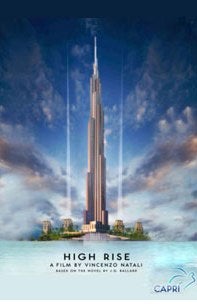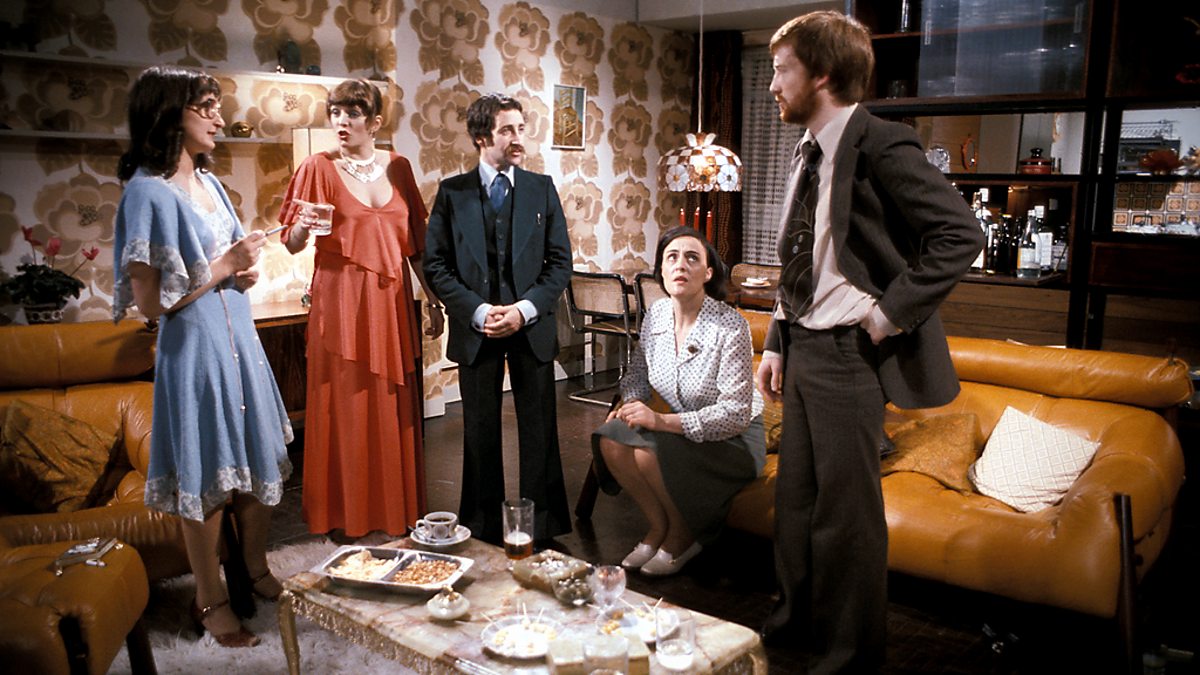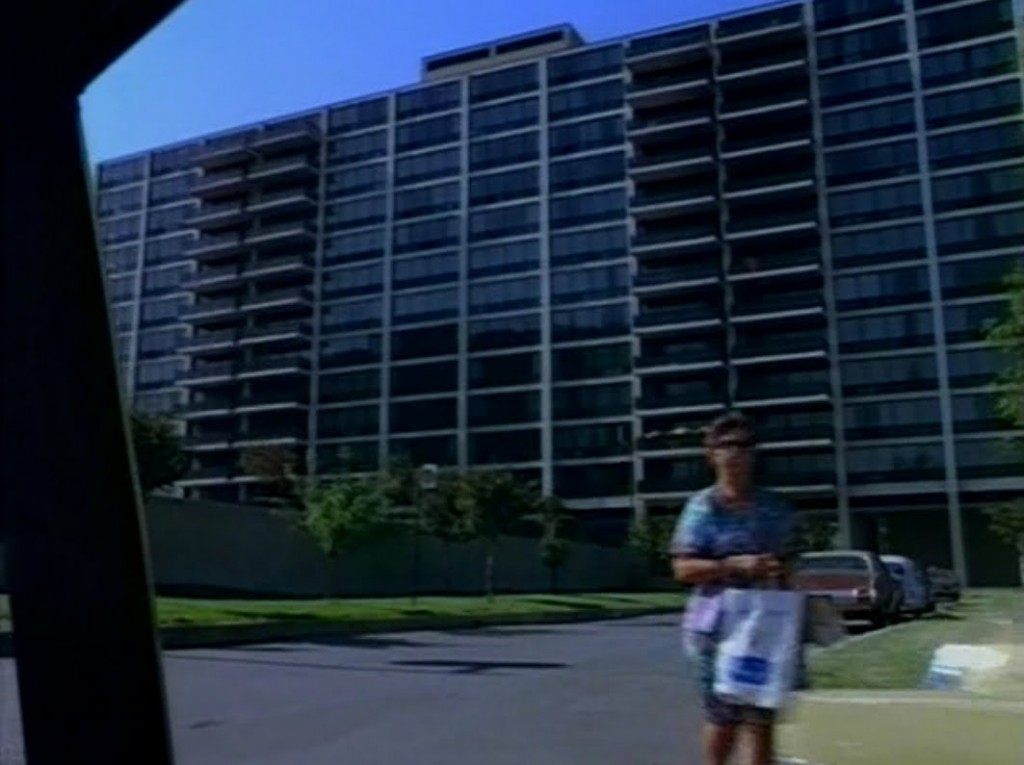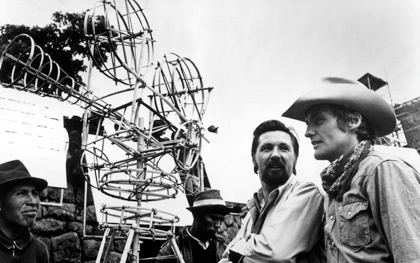 |
| High Rise Live: EV and JR in conversation at the Picturehouse screening Photo: George Bickers |
Last weekend the High Rise preview tour came to the Cambridge Picturehouse. There was to be a special screening plus a post-film Q&A chaired by Evie Salmon. Good stuff. A fortuitous turn of events on the day resulted in me being drafted in to act as the interviewee on the night. I was, of course, more than happy to do this. In fact I was delighted to be asked....
The screening was sold out and after a quick planning conference Evie and I held court on the work of Jeremy Thomas, the unrealized 'ghost' versions of High Rise and hauntological messages from the future. I've added something akin to a transcript below. Many thanks to Evie for the invite and many thanks to the Cambridge Picturehouse for their hospitality.
*
EV: High Rise is being touted, rightly so, as another great film from Amy Jump and Ben Wheatley. We'll talk about the Writer / Director team in a moment. Let's just start though by talking about the film's equally distinctive producer, Jeremy Thomas. How do you think High Rise fits in with the rest of his oeuvre?
JR: I think it fits very well. In fact I think Jeremy Thomas's signature is all over this. Thomas seems to approach his work as a producer in a manner similar to that of a curator. He seems to commission, as it were, the films he would like to see. He's not unlike the Tony Wilson of independent film. In terms of outlook and attitude, High Rise sits right alongside Thomas's other adaptations of 'difficult', post-1945 works of fiction. He did Naked Lunch with David Cronenberg in 1991 and of course Cronenberg's 'other' J.G. Ballard adaptation Crash in 1996. In 1990 he produced Bernardo Bertolucci's film of The Sheltering Sky (1949) by Paul Bolwes and he also produced David Mackenzie's version of Alexander Trocchi's Young Adam (1954) in 2003. He's done other projects and his portfolio is admirably extensive but there is this consistent return to film projects based on controversial, if not transgressive texts and film projects which help to develop the work of challenging, idiosyncratic directors. On the basis of that modus operandi, doing Ballard's High Rise (1975) with Jump and Wheatley makes complete sense.
Having said that, I would imagine that for Thomas there's quite a degree of personal investment in this particular film. I believe he's held the rights to the novel for the best part of 30 years. There have been at least two other attempts in that time of bringing it to the screen with Thomas as producer. The first was with Nicolas Roeg in the late 1970s. Paul Mayersberg worked on the screenplay after The Man Who Fell to Earth (1976) and Roeg was all set for it before ultimately opting to make Bad Timing (1980), also produced by Thomas. I think Roeg was a good choice for High Rise. Certainly Performance (1970) and Walkabout (1971) both have an emphasis on transformative 'zones' that's not dissimilar to the type of spaces one finds in Ballard. Whatever the reason for it not coming together, let's just pause and imagine what could have been: a version of High Rise by Roeg possibly featuring David Bowie as Royal, Art Garfunkel as Laing and Theresa Russell as Charlotte Melville. I would have liked to have seen that....
 |
| Toronto high rise: Cronenberg's Crash (1996) |
Having said that, I would imagine that for Thomas there's quite a degree of personal investment in this particular film. I believe he's held the rights to the novel for the best part of 30 years. There have been at least two other attempts in that time of bringing it to the screen with Thomas as producer. The first was with Nicolas Roeg in the late 1970s. Paul Mayersberg worked on the screenplay after The Man Who Fell to Earth (1976) and Roeg was all set for it before ultimately opting to make Bad Timing (1980), also produced by Thomas. I think Roeg was a good choice for High Rise. Certainly Performance (1970) and Walkabout (1971) both have an emphasis on transformative 'zones' that's not dissimilar to the type of spaces one finds in Ballard. Whatever the reason for it not coming together, let's just pause and imagine what could have been: a version of High Rise by Roeg possibly featuring David Bowie as Royal, Art Garfunkel as Laing and Theresa Russell as Charlotte Melville. I would have liked to have seen that....
The other version I know about was also to have been produced by Thomas with a screenplay by Richard Stanley and directed by Vincenzo Natali. This came up in about 2010. Again, I think this was a very good choice as a creative team. Stanley had dealt with weird events in a tower block in his classic Hardware (1990) and Natali had done brilliant things with ideas of entrapment and enclosure in Cube (1997). A poster emerged for this version and I believe they had opted to re-imagine the novel's London high-rise as the 'Elysium Tower', a contemporary, super-modern residential building in the middle of the sea.
 |
| Teaser poster from the unrealized High Rise |
EV: Do you think this 'up-dated' version of the film would have worked?
JR: No. Stanley and Natali are brilliant film-makers and I'm sure this would have been an extremely interesting dystopian film, but I don't think it would have been a very accurate J.G. Ballard film. Apparently Thomas pushed a futurological take on the book and there is something prophetic about Ballard's writing. But at the same time he's very much an author of the mid-20th century. High Rise, the novel, is deeply inscribed into its social, economic and material context: Britain in the 1970s. Ballard is, in essence, a science fiction author but he's invariably terrestrial. He's far more interested in inner rather than outer space and his project is to look at the psychopathology of the world, particularly the architecture he sees around him. High Rise is his attack, so to speak, on the material and psychological culture of the 1970s. Its events, scenarios and narrative structure would have to change significantly to set it anywhere (or any-when) else. I just don't think the idea would work in a world of mobile phones, social media, out-sourced private security and total surveillance.
About same time that Stanley was developing High Rise, he was also slated to write and direct another project called Vacation. Vacation featured two American tourists stuck in "a seedy Middle Eastern resort" due to "freak solar storms that eradicate all means of communication". This is purely speculative on my part but I would imagine that to make its scenario half-way feasible this contemporary version of High Rise would have had to involve something similar: somekind of external force or event that causes the building to be cut-off. An interesting idea but not necessarily what Ballard was getting at. This is a long, roundabout way of saying that the main success of Wheatley's version is the fact that it is set specifically in the 1970s.
About same time that Stanley was developing High Rise, he was also slated to write and direct another project called Vacation. Vacation featured two American tourists stuck in "a seedy Middle Eastern resort" due to "freak solar storms that eradicate all means of communication". This is purely speculative on my part but I would imagine that to make its scenario half-way feasible this contemporary version of High Rise would have had to involve something similar: somekind of external force or event that causes the building to be cut-off. An interesting idea but not necessarily what Ballard was getting at. This is a long, roundabout way of saying that the main success of Wheatley's version is the fact that it is set specifically in the 1970s.
EV: In the light of this long gestation then, you're saying that Jeremy Thomas finally found the perfect director in Ben Wheatley?
JR: I think it certainly makes sense for Wheatley to be making this type of film at this stage in his career. It's the right kind of step-up in terms of budget, cast, exposure etc after films like Kill List (2011) and A Field in England (2013). On a more symbolic level I guess there's what you might call a 'spiritual' inheritance at play with Wheatley making the film. He's on record talking about the influence of Roeg on his own work. At that level its appropriate that he's now taken on and completed Roeg's previously unrealized project. More specifically High Rise fits in very well with Wheatley's ongoing mining of 1970s British culture and what appears to be a developing pre-occupation for dealing with aspects of the British psyche. With A Field in England he looked at aspects of British folklore and Sightseers (2012) analyzed the not-so implicit violence that underwrites the British attitude to the tourist landscape. High Rise shifts focus to urbanism but not without maintaining an emphasis on classic British obsessions: class, manners, status. For all its violence, there's something strangely passive aggressive about both the book and the film. Its savagery comes from the same psychic battlefield covered in the likes of Abigail's Party (1977).
EV: Would you say that Wheatley has come up with a film that's particularly Ballardian?
JR: There are some differences between the novel and Amy Jump's script so, as with any other adaptation, its not totally faithful to the text. That said, I think the film does get the Ballardian sensibility pretty much bang-on. By that I mean Ballard works through a very particular paradigm within his fiction. His concept of inner space is based upon an awareness of a feedback loop between an individual and their built environment. This is one of the primary preoccupations of Ballard's so-called 'Concrete and Steel' trilogy: Crash (1973), Concrete Island (1974) and High Rise. To put it bluntly, in High Rise, Ballard attributes a ambiguous level of agency to the building itself. The events of the novel are not neo-Luddite acts of agitation against architecture but are the results of the building realizing its design. The challenge and difficulty of Ballard's writing lies in accepting these events as things to be welcomed if not actively sought out. When seen in the context of Ballard's wider work it is not intended as 'dystopian'.
This is what separates Ballard from a number of comparable texts. There's Cronenberg's first main feature, Shivers (1975) and John Wagner's Judge Dredd story for 2000AD, 'Block Mania' (1981). In Shivers, a strange parasite infects a luxury apartment block leading to all kinds of psycho-sexual chaos. In 'Block Mania' a two gigantic residential towers go to war. Whilst ostensibly similar to High Rise, both of these scenarios are based on the introduction of something 'other' to an otherwise stable community: a hitherto unknown parasite and water-borne poison. This type of 'alien' entity simply does not exist in High Rise. What Ballard describes can be taken as either an amplification of what's already there in the residents or some other form of response to the corporate stricture. Either way there's something about the building that fascinates Ballard. Wheatley and Jump, I think, make this very clear. It would have been really easy to do a kind of 28 Days Later in a tower block but they wisely focus on the strange attraction and resonances of the building's structure to the extent that it becomes a character. The glimpse we get of Royal's synaptic schematics puts this psychogeographical aspect firmly in the frame. It's very much, as Ballard says in the novel, a case of Laing being "exhilarated by the high rise".
EV: We've spoken a lot about Ben Wheatley. I think we need to talk about the other side of this creative process, Amy Jump's excellent screenplay. Clearly, she's absorbed much of the ambience of the novel but as you say, there are some changes. Changes for the better?
JR: The changes make for a better film in these sense that the characters are a little more fleshed out. Ballard basically brings together a series of ciphers and sets them to work in the scenario he builds for the text. They are as hermetic as the building because there's very little in the way of any backstory. In addition to developing characters like the boy Toby, Jump does a good job of giving Laing not so much a pre-history as a little more depth. The scenes of him in the teaching hospital and the way that they feed into an integral subplot add a veneer of complexity to the psychological interactions of the film. There's a sense that Laing has something fermenting before he starts getting involved in the psychotic cocktail parties.
Aside from matters of plot one thing that does change is some aspects of the technological specificity that Ballard makes use of. When Wilder begins to climb the high rise under the auspices of making his documentary he is described as carrying a cine-camera. In the film this becomes an early video camera linked to a portable VCR. Although its far from the most implausible aspect of the film in one sense this is an effective change. Technically a cine-camera would give Wilder only a few minutes of filming time per reel: good for the sleazy bathroom porn that's made in the film but not good for a documentary. But that said, Ballard didn't drop the ball here, he just used references to technology in a different way. Wheatley and Jump use the video camera almost as a non-anachronistic means of Wilder taking a selfie. For Ballard, the whole point was that Wilder would run out of film quickly. This allows Ballard to then describe Wilder brandishing an empty camera as he climbs further up, as if it is a totemic residue of his 'past' life, a bit like the wicker camera in Dennis Hopper's The Last Movie (1971).
EV: I thought the aesthetics of the film were rendered beautifully. It looked great but at the same time was somewhat lo-fi. This seemed to come out not only in the way that the film looked but also how it sounded. I'm thinking in particular of Portishead's version of ABBA's 'SOS' (1975). The song came out in the same year as the novel. Using the contemporary cover allows it to work as a kind of dissonant parallel: historically accurate but at the same time uncanny.
JR: Yes, that's a real high point in the film. It goes hand in hand with the very accurate rendition of the film's entire, enclosed world. Sonically and visually the whole thing feels extremely real: solid. But as you say it's twisted in the direction of an alternative, altered image. For me the dissonance you describe comes out mostly strongly in some of the set design. The interiors of the high rise itself, particularly the corridors, the lobbies and aspects of the tower garden really remind me of a set of buildings in Marseilles designed by Le Corbusier. Known collectively as the Radiant City (1947-1952), they were built according the architectural principles of the unite d'habitation. Essentially this is a philosophy of modernist design that works to establish an invigorating and improving relationship between the inhabitant and their environment. The main block in Marseilles is a fascinating building that works as a type of modernist sun temple. It has long,dark corridors that open out into blazing sun traps. The roof has a wonderful, almost surreal concrete garden. Royal would feel very at home there. The look of the high rise in the film really calls this to mind.
EV: Marseilles is linked to a project of yours I believe?
JR: Yes very much so, thanks for the plug! Along with the writer and poet David Ashford, I'm making a film about the Radiant City and Unite d'habitation. Not a documentary exactly but rather a speculative piece that connects Marseilles to High Rise. Its based around the (fictional) conceit that not only did Ballard take the building as the inspiration for High Rise but that he based the novel as a whole upon a series of events that took place there. One of Ballard's earlier short stories, 'The Thousand Dreams of Stellavista' (1962) uses the device of a 'psychotronic house': a building that responds to the mood of the occupant, records those moods and 'replays' them back in an odd, affective feedback loop. Of course, the interest for Ballard lies in the potential of this structure to record and replay the affective results of a traumatic event to another inhabitant. Our film takes this idea as its central theme and hypothesizes that Le Corbusier's building has somehow absorbed the events of its fictional double, and this information can be accessed by performing of a series of psychogeographic practices in situ. David and I spent a few days there, getting a sense of the atmosphere in the concrete garden, shooting loads of video and generally running up and down the corridors yelling at each other. As ever, its a work in progress but its coming together well. The finished film will use different kinds of video and cine footage to do a kind of High Rise remix: Ballard re-situated in Marseilles and mixed with Le Corbusier's brutalist utopianism.
EV: Towards the end of the film, we see a young boy looking to the air with a home-made radio. We hear Margaret Thatcher's speech to the House of Commons on 24 November 1976 when she was leader of the opposition. Then we hear The Fall's 'Industrial Estate', released in 1979, the year Thatcher comes to power as Prime Minister. So what's this, High Rise as a test bed for Thatcherism? A radio broadcast from the future that breaks into this documentary on urban planning and the problems arising from shared freehold?
JR: You're absolutely right. I think its precisely those carefully chosen details that prevent the film from being 'just' a 1970s pastiche. It makes the film somewhat hauntological in its politics. The boy tunes into the near future but seen in 2016 it's a mournful futurology: we're invited to lament what this 'future' became.
*




No comments:
Post a Comment